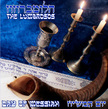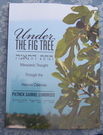And do not fear those who kill the body but cannot kill the soul. Rather fear him who can destroy both soul and body in hell.
In his exhortation to the Children of Israel towards obedience to God, Moses reminds them of the sin of the Golden Calf; he warns them against idolatry with the words, For Adonai your God is a consuming fire, a jealous God (Deuteronomy 4:24). The writer of the Book of Hebrews admonishes his readers to obedience using this same passage (Hebrew 12:29).
For you have not come to what may be touched, a blazing fire and darkness and gloom and a tempest (Mt Horeb) … But you have come to Mount Zion (in Jerusalem where Messiah was crucified). This whole chapter is usually read as an antithesis between Mt Horeb and Mt Zion. It is usually interpreted in the assumption of a spiritual opposition between the two mountains: "you haven't come to Moses, but to Yeshua; not to the Torah, but to 'grace'; not to the Old Testament, but to the New. God was mean before, but now He is nicer!". This is a flawed understanding and even a minimal understanding of not only the context of the chapter, but also of the style of Jewish writers reveals it.
In this passage the writer makes a point for people to obey and fear God's discipline (Hebrews 12: 1-17) using the traditional 'kol v'homer' argument so often used by Paul, Yeshua, all the prophets and apostolic writers. In the same manner that Yeshua said (my narration) "if God clothes the lilies of the field which are here today and burned tomorrow better than even King Solomon in all his glory, won't he also clothe you?", the writer of Hebrews declares, "you think Mount Horeb, the mountain of Moses and of the congregation in the desert was so awesomely terrible that people who disobeyed died a terrifying death? Mt Zion, the mountain of the firstborn (Yeshua) in Jerusalem is even more deserving of your respect." He says; See that you do not refuse him who is speaking. For if they did not escape when they refused him who warned them on earth (Moses), much less will we escape if we reject him who warns from heaven (Yeshua) (Hebrews 12:25). Now we get the intended message: "You saw what happen to those who disobeyed at Mt Horeb? Mt Zion is even more terrifying!"
In this day and age people tend to have a very familiar relationship with Yeshua; they remember the baby born in Bethlehem, He who cried at the death of His friend Lazarus, the gentle Lamb who opened not His mouth as He was reviled by both His brothers and the pagans. We tend to forget though that the baby grew up to be the returning King clothed in a garment dipped in blood, and vested in all the authority and power of God to execute judgment and vengeance on His enemies and on all those who defy His rule (Revelations 19). He is able not only to kill the body, but He can destroy both soul and body in hell (Matthew 10:28).
May we stand and be warned: Serve Adonai with fear, and rejoice with trembling. Kiss the Son, lest he be angry, and you perish in the way, for his wrath is quickly kindled. Blessed are all who take refuge in him (Psalms 2:11-12).
 RSS Feed
RSS Feed


